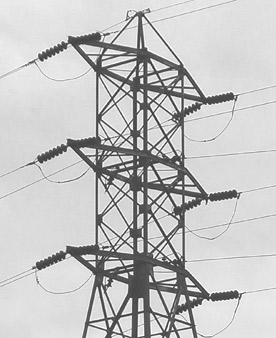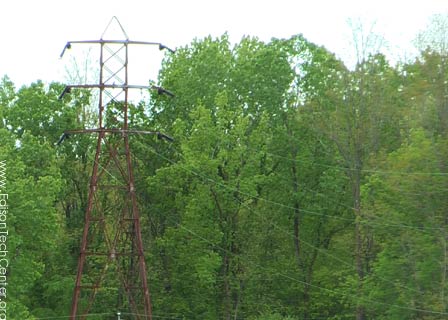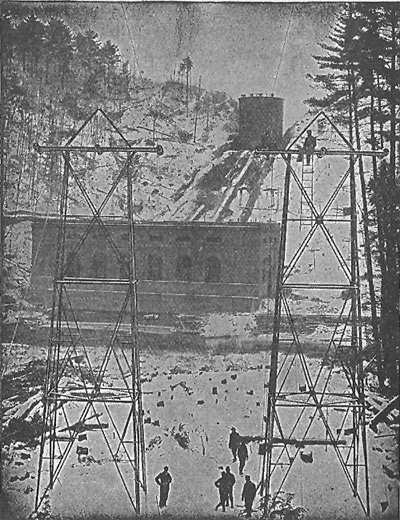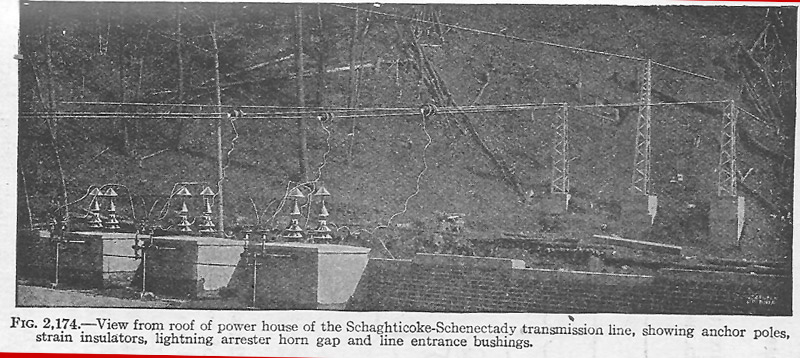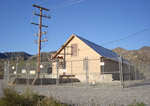
Schaghticoke Power Station 1908
Hydro power station used for early experiments by C.P. Steinmetz
Steinmetz's Experimental Power Line
Schaghticoke-Schenectady power line was a testing ground for new power grid technology
Charles Steinmetz, pioneer of AC power started a new project in 1908. His goal was to make a new power transmission system to rival the Westinghouse system. He connected the small hydro-power station at Schaghticoke (built in 1902) with Mechanicville 8 miles away. He invented the monocyclic 3 phase system for power transmission. On the transmission lines there were 3 wires, one with a phase of 270 degrees, and two with 90 degrees. They operated at 40 cycles per second. The line operated at 32,000 volts. The experimental line was linked with the existing Mechanicville-Schenectady power line.
Advantages: The new system had the advantage of being able to run an electric motor without need for a centrifugal switch. This would allow for smaller electric motors, and no failures of electric motors caused by the sticking of the starting clutch (a common cause of electric motor burn out).
The centrifugal switch connects a starting winding in the circuit until the motor is up to speed. Then the switch opens because this winding is not designed for continuous operation.
Another advantage was that it was a current constant line: the power line was self adjusting. If you use more power, the voltage would rise to meet the need.
Disadvantages: Steinmetz's new system had the disadvantage of not handling lighting strikes well. When lightning struck the system, the current was sent down the line.
How a Monocyclic Power System Works:
Invented by C. P. Steinmetz in Schenectady, NY"The monocyclic system is essentially a single-phase system, consisting of two wires in combination with a third auxiliary, or teaser wire; the main lines being used for supplying lights, while the the third wire which carries the intermediate, or displaced, current, is used together with the main lines for supplying power to polyphase motors.The teaser wire need only be run to the motors. Indeed, the teaser wire need not start from the generator,but may start from any motor, or multiple-circuit apparatus of the system. The motors operate practically the same as polyphase motors. As the lights are connected to the single-phase circuit, there is no possibility of unbalancing. The monocyclic generator can be loaded to the fullest extent with either lights or motors, or partly with the lights and partly with motors, in any proportion.
It has been noted that the regulation of polyphase generators varies with the inductive character of the load. The monocyclic generator, when designed with a shunt and series excitation, possesses the superior advantage of the automatically compounding for all kinds of load. The power wire of the monocyclic system supplies the magnetizing current to the motors, which current is returned over the main wires, adding to the magnitude of the current in one lead, and reducing it in the other. The commutating device is placed in the main carrying the largest current. As the increase over the normal depends on the motors, ... "
-Excerpt from Standard Polyphase Apparatus and Systems 1899 by Maurice Agnus Oudin
Over time Steinmetz's power line was later linked up with other small hydro projects like Victory Mills, 14 miles to the north. The Hudson Transmitting Power Company owned these systems.
The place where Steinmetz's line crossed the Hudson River within view of the Mechanicville power station.
Beginning of the Schaghticoke transmission line showing power station in the background
Eventually Steinmetz's project was stopped due to the fact that Westinghouse had already controlled so much of the market that it was going to be impossible to break into the market with this new system. The powerline was then converted to a 3 phase Delta system in the 1920's.
Today the power line operates at 34,500 volts. The power station at Schaghticoke produces 16.4 megawatts.
Continued Research 1936:
Albert W. Hull of GE worked on HVDC transmission from Mechanicville to Schenectady, and converting the 40 Hz to 60 Hz.
Continued Research:
Multi-phase power transmission research continued over the years. Twelve-phase was the most ever created and that research was done by Dr. Oliver Winn at General Electric. The 12-phase system worked well when converted to DC, it made a smooth transition.Other Early Power Transmission History Sites:
Mechanicville Power Station, Mechanicville, New York 1897
Folsom Powerhouse, Folsom California 1895
Redlands Mill Creek 1 powerhouse Redlands, CA 1893Great Barrington 1886 The first AC power distribution system using transformers
References:
Hawkins Electrical Guide #5 Theo Audel and Co. 1917
Harnessing the Hudson by Dr. Paul Loatman
The General Electric Story by the Hall of Electrical History
Men and Volts by John Hammond
History of High Voltage Direct Current Transmission by Owen Peake
Monocyclic Power, A Novel but Short-Lived Power Distribution System by Thomas Blalock, IEEEPhotos: M. Whelan, and Hawkins Electrical Guide #5
Article by: M. Whelan, reviewed by Tom Blalock
Photo/Video use:
Commercial entities must pay for use of photos/graphics/videos in their web pages/videos/publications
No one commercial or public is allow to alter Edison Tech Center photos/graphics/videos.
Educational Use: Students and teachers may use photos and videos for school. Graphics and photos must retain the Edison Tech Center watermark or captions and remain unmanipulated except for sizing.Permissions - Videos: We do not email, FTP, or send videos/graphics to anyone except in DVD form. Payment is needed for this service. See our donate page for pricing, and our catalogue for a listing of videos on DVD.
Professional video production companies may get videos in data form with signed license agreements and payment at commercial rates.
Copyright 2014 Edison Tech Center

